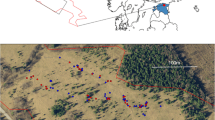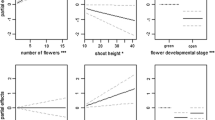Summary
Females of an odonate species in which oviposition sites overlap with mating sites may adopt one or more of the following strategies when they lay eggs except when they ‘trade’ mating for access to suitable oviposition sites or for services (guarding, etc.) provided by males: (1) ovipositing at hidden places; (2) ovipositing at a time when males are neither patrolling nor watching; (3) indicating non-receptivity by a behavioral display. The density of ovipositing females of the dragonfly,Cordulia aenea amurensis Selys which was studied between 1970 and 1983 at a pond (Hôrai-numa, Sapporo, Hokkaido) had a high negative correlation with the distance from ‘entrance’ (a part of shore at which the arrival of most adults seems to have occurred). On the other hand, oviposition was rarely observed at a sector being distant from entrance in spite of the inference that larval survivorship was probably high at this sector. Most females oviposited among emergent vegetation in which approach of males to them was difficult, and they scarcely traveled across the open water in search of oviposition sites. Therefore, most females of the population studied were considered to adopt the first strategy. The second and third strategy were not adopted by the population studied. Finally, the influences of some environmental factors and traits possessed by a species on the adoption of these tactics or on the execution of the ‘trades’ were discussed.
Similar content being viewed by others
References
Alcock, J. (1982) Post-copulatory mate guarding by males of the damselflyHetaerina vulnerata Selys (Odonata: Calopterygidae).Anim. Behav. 30: 99–107.
Aoyanagi, M. (1973) Observations of actions and postures of the adult damselflyCeriagrion melanurum Selys (Odonata: Agrionidae)—Studies on adult behavior of the damseflyCeriagrion melanurum Selys, 1.Kontyû 41: 241–253 (In Japanese with English summary).
Arai, Y. (1977) Behavior of mature individuals ofCercion sieboldii Selys (Agrionidae).Tombo 20: 13–16 (In Japanese with English summary).
Arai, Y. (1979) Mating behavior and refusal of copulation by mature females ofIschnura asiatica Brauer.Nature and Insects, Tokyo 14(6): 38–41 (In Japanese).
Baker, R. L. (1982) Effect of food abundance on growth, survival, and use of space by nymphs ofCoenagrion resolutum (Zygoptera).Oikos 38: 47–51.
Bartenef, A. (1932) Über die Tagskurven des Fluges vonAeschna juncea L. (Odonata) an Hochgebirgsgewässern.Zool. Anz. 98: 91–94.
Bick, G. H. (1966) Threat display in unaccompanied females of the damselfly,Ischnura verticalis (Say) (Odonata: Coenagriidae).Proc. Ent. Soc. Wash. 68: 271.
Brittain, J. E. (1983) The influence of temperature on nymphal growth rates in mountain stoneflies (Plecoptera).Ecology 64: 440–446.
Consiglio, C. (1974) Some observations on the sexual behaviour ofPlatycypha caligata (Selys).Odonatologica 3: 257–259.
Corbet, P. S. (1957) The life history of the emperor dragonfly,Anax imperator Leach (Odonata: Aeshnidae).J. Anim. Ecol. 26: 1–69.
Corbet, P. S. (1962)A biology of dragonflies. Witherby, London.
Crumpton, W. J. (1975) Adult behavior ofXanthocnemis zealandica McLachlan andAustrolestes colensonis White at selected South Island (N. Zealand) habitats. (Zygoptera: Coenagrionidae, Lestidae).Odonatologica 4: 149–168.
Dillon, P. M. (1981) Community dynamics in odonates: interactions within and between life stages. Ph.D thesis Univ. Michigan, Ann Arbor.
Fincke, O. M. (1984) Sperm competition in the damselflyEnallagma hageni Walsh (Odonata: Coenagrionidae): benefits of multiple mating to males and females.Behav. Ecol. Sociobiol. 14: 235–240.
Gilbert, L. E. andM. C. Singer (1975) Butterfly ecology.Ann. Rev. Ecol. Syst. 6: 365–397.
Hassan, A. T. (1976) The effect of food on the larval development ofPalpopleura lucia lucia (Drury) (Anisoptera: Libellulidae).Odonatologica 5: 27–33.
Hilton, D. F. J. (1983a) Reproductive behavior ofCordulia shurtleffi Scudder, (Anisoptera: Corduliidae).Odonatologica 12: 15–23.
Hilton, D. F. J. (1983b) Territoriality inLibellula julia Uhler (Anisoptera: Libellulidae).Odonatologica 12: 115–124.
Krebs, C. J. (1978)Ecology: The experimental analysis of distribution and abundance. Second edition. Harper and Row.
Krieger, F. andE. Krieger-Loibl (1958) Beiträge zum Verhalten vonIschnura elegans undIschnura pumilio (Odonata).Z. Tierpsychol. 15: 82–93.
Lawton, J. H., B. A. Thompson andD. J. Thompson (1980) The effect of prey density on survival and growth of damselfly larvae.Ecol. Ent. 5: 39–51.
Macan, T. T. (1964) The odonata of a moorland fish-pond.Int. Rev. Hydrobiol. 49: 325–360.
Maynard Smith, J. (1976) Evolution and the theory of games.Amer. Sci. 64: 41–45.
Miller, P. L. andC. A. Miller (1981) Field observations on copulatory behaviour in Zygoptera, with an examination of the structure and activity of the male genitalia.Odonatologica 10: 201–218.
Obara, Y. (1964) Mating behaviour of the cabbage white,Pieris rapae crucivora. 2. The ‘mate-refusal posture’ of the female.Zool. Mag. (Dôbutsugaku Zasshi)73: 175–178 (In Japanese with English summary).
Okazawa, T. andH. Ubukata (1978) Behaviour and bionomics ofEpiophlebia superstes (Selys) (Anisozygoptera: Epiophlebiidae). I. Daily and seasonal activities.Odonatologica 7: 135–145.
Parker, G. A. (1970) Sperm competition and its evolutionary consequences in the insects.Biol. Rev. 45: 525–568.
Parker, G. A. (1972) Reproductive behaviour ofSepsis cynipsea (L.) (Diptera: Sepsidae) I. A preliminary analysis of the reproductive strategy and its associated behaviour patterns.Behaviour 41: 172–206.
Parker, G. A. (1979) Sexual selection and sexual conflict. InM. S. Blum andN. A. Blum (eds)Sexual selection and reproductive competition in insects. Academic Press.
Rausher, M. D. (1979) Larval habitat suitability and oviposition preference in three related butterflies.Ecology 60: 503–511.
Robert, P. A. Les libellules (Odonates). Delachaux et Nistlé S. A., Neuchâtel.
Rowe, R. J. (1978)Ischnura aurora (Brauer), a dragonfly with unusual mating behavior (Zygptera: Coenagrionidae).Odonatologica 7: 309–416.
Rutowski, R. L. (1978) The courtship behaviour of the small sulphur butterfly,Eurema lisa (Lepidoptera: Pieridae).Anim. Behav. 26: 892–903.
Sakagami, S. F., H. Ubukata, M. Iga andM. J. Toda (1974) Observations on the behavior of some Odonata in the Bonin Islands, with considerations on the evolution of reproductive behavior in Libellulidae.J. Fac. Sci., Hokkaido Univ. Ser. VI 19: 722–757.
Southwood, T. R. E. (1978)Ecological methods.Second edition. Chapman and Hall, London.
Spieth, H. T. (1981) Courtship behavior and evolutionary status of the HawaiianDrosophila primaeva Hardy andKaneshiro.Evolution 35: 815–817.
Thornhill, R. andJ. Alcock (1983)The evolution of insect mating systems. Harvard Univ. Press.
Trivers, R. L. (1972) Parental investment and sexual selection. InB. Campbell (ed)Sexual selection and the descent of man. Aldine, Chicago.
Ubukata, H. (1973) Life history and behavior of a corduliid dragonfly,Cordulia aenea amurensis Selys. I. Emergence and prereproductive periods.J. Fac. Sci., Hokkaido Univ. Ser. VI 19: 251–269.
Ubukata, H. (1974) Relative abundance and phenology of adult dragonflies at a dystrophic pond in Usubetsu, near Sapporo.J. Fac. Sci., Hokkaido Univ. Ser. VI 19: 758–776.
Ubukata, H. (1975) Life history and behavior of a corduliid dragonfly,Cordulia aenea amurensis Selys. II. Reproductive period with special reference to territoriality.J. Fac. Sci., Hokkaido Univ. Ser. VI 19: 812–833.
Ubukata, H. (1980) Life history and behavior of a corduliid dragonfly,Cordulia aenea amurensis Selys. III. Aquatic period with special reference to larval growth.Kontyû 48: 414–427.
Ubukata, H. (1981) Survivorship curve and annual fluctuation in the size of emerging population ofCordulia aenea amurensis Selys (Odonata: Corduliidae).Jap. J. Ecol. 31: 335–346.
Ubukata, H. (1983) An experimental study of sex recognition inCordulia aenea amurensis Selys (Anisoptera: Corduliidae).Odonatologica 12: 71–81.
Ubukata, H. (1984) Intra-male sperm translocation and copulatory behavior in the dragonfly,Cordulia aenea amurensis Selys (Odonata; Corduliidae).J. Hokkaido Univ. Educ. (Sect. IIB) 35: 43–52.
Uéda, T. (1976) The breeding population of damselfly,Cercion calamrum Ris (Odonata: Zygoptera) I. Daily movements and spatial structure.Physiol. Ecol. Japan 17: 303–312 (In Japanese with English summary).
Waage, J. K. (1979a) Dual function of the damselfly penis: Sperm removal and transfer.Science 203: 916–918.
Waage, J. K. (1979b) Adaptive significance of postcopulatory guarding of mates and nonmates by maleCalopteryx maculata (Odonata).Behav. Ecol. Sociobiol. 6: 147–154.
Wiklund, C. (1977) Oviposition, feeding and spatial separation of breeding and foraging habitats in a population ofLeptidea sinapis (Lepidoptera).Oikos 28: 56–68.
Author information
Authors and Affiliations
Additional information
Ecological studies ofCordulia aenea amurensis Selys, VII.
This work was supported in part by a Grant-in-Aid for Special Project Research on Biological Aspects of Optimal Strategy and Social Structure from the Japan Ministry of Education, Science and Culture.
Rights and permissions
About this article
Cite this article
Ubukata, H. Oviposition site selection and avoidance of additional mating by females of the dragonfly,Cordulia aenea amurensis Selys (Corduliidae). Res Popul Ecol 26, 285–301 (1984). https://doi.org/10.1007/BF02515495
Issue Date:
DOI: https://doi.org/10.1007/BF02515495




